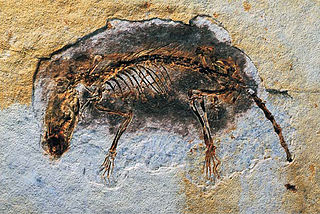Related Research Articles
In chemistry, dimerization is the process of joining two identical or similar molecular entities by bonds. The resulting bonds can be either strong or weak. Many symmetrical chemical species are described as dimers, even when the monomer is unknown or highly unstable.

The sella turcica is a saddle-shaped depression in the body of the sphenoid bone of the human skull and of the skulls of other hominids including chimpanzees, gorillas and orangutans. It serves as a cephalometric landmark. The pituitary gland or hypophysis is located within the most inferior aspect of the sella turcica, the hypophyseal fossa.

Kidney disease, or renal disease, technically referred to as nephropathy, is damage to or disease of a kidney. Nephritis is an inflammatory kidney disease and has several types according to the location of the inflammation. Inflammation can be diagnosed by blood tests. Nephrosis is non-inflammatory kidney disease. Nephritis and nephrosis can give rise to nephritic syndrome and nephrotic syndrome respectively. Kidney disease usually causes a loss of kidney function to some degree and can result in kidney failure, the complete loss of kidney function. Kidney failure is known as the end-stage of kidney disease, where dialysis or a kidney transplant is the only treatment option.

Sheehan's syndrome, also known as postpartum pituitary gland necrosis, occurs when the pituitary gland is damaged due to significant blood loss and hypovolemic shock or stroke, originally described during or after childbirth leading to decreased functioning of the pituitary gland (hypopituitarism). Classically, in the milder partial form, the mother is unable to breastfeed her baby, due to failure of the pituitary to secrete the hormone prolactin, and also has no more periods, because FSH and LH are not secreted. Although postmenopausal, the mother with this milder form of Sheehan's syndrome does not experience hot flushes, because the pituitary fails to secrete FSH. The failure to breastfeed and amenorrhea no more periods, were seen as the syndrome, but we now view Sheehan's as the pituitary failing to secrete 1-5 of the 9 hormones that it normally produces (the anterior lobe of the pituitary produces FSH, LH, prolactin, ACTH ,TSH and GH ; the posterior pituitary produces ADH and Oxytocin, i.e. the pituitary is involved in the regulation of many hormones. It is very important to recognise Sheehan' stroke as, the ACTH deficiency Sheehan's in the presence of the stress of a bacterial infection, such as a urine infection, will result in death of the mother from Addisonian crisis. This gland is located on the under-surface of the brain, the shape of a cherry and the size of a chickpea and sits in a pit or depression of the sphenoid bone known as the sella turcica. The pituitary gland works in conjunction with the hypothalamus, and other endocrine organs to modulate numerous bodily functions including growth, metabolism, menstruation, lactation, and even the "fight-or-flight" response. These endocrine organs,, release hormones in very specific pathways, known as hormonal axes. For example, the release of a hormone in the hypothalamus will target the pituitary to trigger the release thyroid stimulating hormone, and the pituitary's released hormone will target the next organ in the pathway i.e. the thyroid to release thyroxin. Hence, damage to the pituitary gland can have downstream effects on any of the aforementioned bodily functions.

Pituitary adenomas are tumors that occur in the pituitary gland. Most pituitary tumors are benign, approximately 35% are invasive and just 0.1% to 0.2% are carcinomas. Pituitary adenomas represent from 10% to 25% of all intracranial neoplasms, with an estimated prevalence rate in the general population of approximately 17%.

Marginocephalia is a clade of ornithischian dinosaurs that is characterized by a bony shelf or margin at the back of the skull. These fringes were likely used for display. This clade was officially defined in the PhyloCode by Daniel Madzia and colleagues in 2021 as "the smallest clade containing Ceratops montanus, Pachycephalosaurus wyomingensis, and Triceratops horridus". There are two clades included in Marginocephalia: the thick-skulled Pachycephalosauria and the horned Ceratopsia. All members of Marginocephalia were primarily herbivores. They basally used gastroliths to aid in digestion of tough plant matter until they convergently evolved tooth batteries in Neoceratopsia and Pachycephalosauria. Marginocephalia first evolved in the Jurassic Period and became more common in the Cretaceous. They are basally small facultative quadrupeds while derived members of the group are large obligate quadrupeds. Primitive marginocephalians are found in Asia, but the group migrated upwards into North America.

Tribosphenida is a group (infralegion) of mammals that includes the ancestor of Hypomylos, Aegialodontia and Theria. It belongs to the group Zatheria. The current definition of Tribosphenida is more or less synonymous with Boreosphenida.
In chemistry, a superatom is any cluster of atoms that seem to exhibit some of the properties of elemental atoms.

Empty sella syndrome is the condition when the pituitary gland shrinks or becomes flattened, filling the sella turcica with cerebrospinal fluid instead of the normal pituitary. It can be discovered as part of the diagnostic workup of pituitary disorders, or as an incidental finding when imaging the brain.

The posterior clinoid processes are the tubercles of the sphenoid bone situated at the superior angles of the dorsum sellae which represents the posterior boundary of the sella turcica. They vary considerably in size and form. The posterior clinoid processes deepen the sella turcica, and give attachment to the tentorium cerebelli, and the dura forming the floor of the hypophyseal fossa.

The anterior clinoid process is a posterior projection of the sphenoid bone at the junction of the medial end of either lesser wing of sphenoid bone with the body of sphenoid bone. The bilateral processes flank the sella turcica anteriorly.

Axenfeld–Rieger syndrome is a rare autosomal dominant disorder, which affects the development of the teeth, eyes, and abdominal region.
Cephalometric analysis is the clinical application of cephalometry. It is analysis of the dental and skeletal relationships of a human skull. It is frequently used by dentists, orthodontists, and oral and maxillofacial surgeons as a treatment planning tool. Two of the more popular methods of analysis used in orthodontology are the Steiner analysis and the Downs analysis. There are other methods as well which are listed below.
Pincer nails are a nail disorder in which the lateral edges of the nail slowly approach one another, compressing the nailbed and underlying dermis. It occurs less often in the fingernails than toenails.

Hypophysitis refers to an inflammation of the pituitary gland. Hypophysitis is rare and not fully understood.

Australaves is a clade of birds, defined in 2012, consisting of the Eufalconimorphae as well as the Cariamiformes. They appear to be the sister group of Afroaves. This clade was defined in the PhyloCode by George Sangster and colleagues in 2022 as "the least inclusive crown clade containing Cariama cristata and Passer domesticus".
Natural head position is a reproducible position of a head when it is in an upright position, with eyes looking straight at a mark. The concept was introduced into the field of orthodontics in the late 1950s by Moorrees and Kean. A horizontal line related to the natural head position has been recommended as the most reliable plane to study cephalometric analysis.

Riaz Haider was an Indian-born American physician, cardiologist, author, and medical educator. He is best known for his work and research in the diagnostic cardiac ultrasound, heart pacemakers, exercise stress testing, and heart catheterization. He was the President of the American Heart Association Nation's Capital Affiliate, and served as a Clinical Professor of Medicine at the George Washington University School of Medicine & Health Sciences, from 1984 to 2011. He was an elected Fellow of the American College of Physicians, the American College of Cardiology, and the Royal College of Physicians. He retired in 2011, and later resided in Potomac, Maryland.
Sex as a biological variable (SABV) is a research policy recognizing sex as an important variable to consider when designing studies and assessing results. Research including SABV has strengthened the rigor and reproducibility of findings. Public research institutions including the European Commission, Canadian Institutes of Health Research, and the U.S. National Institutes of Health have instituted SABV policies. Editorial policies were established by various scientific journals recognizing the importance and requiring research to consider SABV.
References
- 1 2 Wren, M. W. (1969-05-01). "Significance of the so-called J-shaped sella in the diagnosis of intracranial aneurysm". British Journal of Ophthalmology. 53 (5): 307–309. doi:10.1136/bjo.53.5.307. ISSN 0007-1161. PMC 1207361 . PMID 4306328.
- ↑ Yang, Heewon; Kim, Hyukhoon; Kwak, Jae Ryoung; Choi, Sangchun (2019-05-01). "J-Shaped Sella in a 7-Month-Old Infant". Journal of Emergency Medicine. 56 (5): e89–e90. doi:10.1016/j.jemermed.2018.12.048. ISSN 0736-4679. PMID 30711367.